Wagner: Desecrated but Undefeated
RECENTLY I WENT to the San Francisco Opera’s new production of Richard Wagner’s The Flying Dutchman (Der Fliegende Holländer), and I thought I would share my reactions, since they relate to larger issues. (ILLUSTRATION: Richard Wagner (1813-1883).)
It was the first time I had seen The Flying Dutchman performed. I had heard Wagner’s dark and surging overture, but I had only a general idea of the themes of the story. I decided not to read the synopsis in the program, because I did not want to spoil the unfolding of the story by peeking at the end.
Unfortunately, the story was spoiled for me by stage director Nikolaus Lehnhoff in collaboration with set designer Raimund Bauer, costume designer Andrea Schmidt-Futterer, and choreographer Denni Sayers. Their production was a travesty and a desecration of Wagner, by turns distracting, ridiculous, and downright unintelligible.
Wagner’s opera is set along the coast of Norway in the eighteenth or nineteenth century. Lehnhoff’s production seems to be set in some sort of vast industrial cargo hold populated by post-apocalyptic mutants, a setting that renders Wagner’s talk of sailing ships and spinning wheels jarringly anachronistic.
I am told that in traditional productions, the settings are the deck of a sailing ship, the hall in the house of Daland (the ship’s Captain), and a village wharf. In Lehnhoff’s production, there is only a vast box, with riveted steel walls, dressed in only slightly different ways for different scenes, with a translucent scrim always hanging between the stage and the audience. This scrim is emblematic of the whole production: instead of realizing Wagner’s genius on stage, it gets between the audience and the artwork, distracting our attention and muddling our understanding.
I imagine that in traditional productions the sailors are dressed like sailors of the time. Since the music for their choruses is filled with humor and high spirits, I imagine that the choreographers instructed them to swagger a bit and swing from the riggings like the nimble young men they are supposed to be. In Lehnhoff’s production, they are dressed in bulky silver-colored suits that made them look like fire hydrants clad in Samurai armor, costumes that reduced their movements to ungainly waddling and stiff, mechanical gestures that clashed with the spirit and feel of the music.
I also imagine that in traditional productions the Norwegian maidens in Captain Daland’s hall are all thin, pretty young women — I know that is a lot to ask for in the opera world — with fair complexions and rosy cheeks. Their long blonde hair is probably braided, and they are probably wearing long peasant dresses. They sit at spinning wheels spinning wool and singing about their boyfriends. Wagner’s sunny music calls to mind graceful feminine forms and gestures and flowing hair and dresses. In Lehnhoff’s production, however, the maidens look from the waist up like mutant Geishas and from the waist down like the Daleks from Dr. Who? Instead of spinning wool, some of them just spin like tops, while the others move their arms in jerky, robotic gestures. Again, the whole scene clashes with the setting and the spirit of the music.
At least Captain Daland and Mary, the nurse of Daland’s daughter, Senta, both look human. But they look decidedly un-Norwegian, with masses of brown, frizzy, Negroid hair.
But oddly enough, Senta, who is the heroine of the tale, wears what looks like a costume from a traditional production. And not only does she look human — not to mention thin and beautiful — she is decidedly Nordic, the role being sung by Swedish soprano Nina Stemme. The Dutchman, too, wears what appears to be a period costume, and his role was sung by Finnish Bass-Baritone Juha Uusitalo.
I suppose I should be grateful for these lapses into good taste, but they so jarringly clashed with the rest of the production’s perverse and irritating style that they just made me resent it all the more. Like a well-characterized villain, bad art can almost be redeemed if it at least has integrity, a unity of vision and style. Lehnhoff’s production lacks even that.
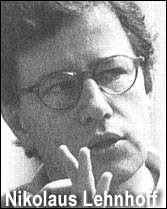 Lehnhoff’s aesthetic crimes go far beyond laughable and distracting costumes and sets. His staging actually makes significant parts of the story unintelligible.
Lehnhoff’s aesthetic crimes go far beyond laughable and distracting costumes and sets. His staging actually makes significant parts of the story unintelligible.
In a traditional staging, I imagine that the Dutchman makes his entrance after his ship pulls up alongside Captain Daland’s ship in the dead of night. In Lehnhoff’s production, the Dutchman simply walks through a door — along with a puff of smoke and a blaze of light and a mysterious rotating propeller effect — and steps onto the deck of Daland’s ship. For all I knew, the Dutchman was already on Daland’s ship and was part of his crew. Only later did I realize that he had come from another ship. The entrance was certainly dramatic, but needlessly confusing. (The drama was heightened by the mirror-like polish of the stage, but when the characters were duplicated by their reflections, they looked like a deck of singing playing cards.)
The Dutchman then launches into his riveting aria “Die Frist ist um” (“The Time is Up”), where he describes his tormented life condemned to wander the oceans, longing for death, seeking death, but condemned to live on in solitude until Judgment Day, when the dead will arise and he will finally attain the annihilation for which he longs. (This is a clear inversion of the Christian scheme and shows an almost Buddhist outlook.)
Later we learn that the Dutchman’s only chance for redemption before Judgment Day is to find a woman who will love him until death. Every seven years, he is allowed to come ashore to search for salvation (which, ironically, means annihilation) through love, and the time has come for another attempt, although the Dutchman’s search for love has failed so many times that he is not optimistic.
Juha Uusitalo’s voice was magnificent, his German understandable, and his performance deeply moving. For a while, I forgot all about Lehnhoff’s perverse production and was swept up in the beauty of the music and the drama of the story. I could not help but identify with the Dutchman’s loneliness and his longing for salvation through love, not to mention his constant disappointment.
Another serious lapse in the production comes in Act II, which is set in the Captain Daland’s hall. In this act, we are introduced to the heroine, Senta, who is Daland’s daughter. We learn that Senta has been infatuated by a fairy tale since childhood. A portrait of the story’s hero hangs on the wall. Senta tells his story in another celebrated aria, “Johohoe, Traft ihr das Schiff” (“Johohoe, Have You Seen the Ship”). I found the story puzzling until about half way through the aria (which is quite long), when it dawned on me that she was telling other aspects of the story of the Dutchman.
In a sensible production, I would have known that immediately, because there would have been a portrait of the Dutchman hanging on the wall, a portrait that the audience could clearly identify as the Dutchman. In Lehnhoff’s production, the picture is referred to but not shown. This was a needless cause of confusion.
The closest thing to the picture in Lehnhoff’s production is a huge shadow of the Dutchman projected on the scrim, which was a nice dramatic touch, but distractingly reminiscent of the silhouette of the hero of the old radio serial The Shadow.
The Dutchman has used his immense wealth to persuade Daland to betroth him to Senta. Although the Dutchman can be saved only by a woman who loves him and remains faithful until death, in his desperation, he in effect purchases a bride he has never seen in a loveless arranged marriage. It seems self-defeating, but this kind of delusional thinking is depressingly common among men when it comes to matters of the heart. Fortunately for the Dutchman, Senta already loves him from hearing his tale as a child. Senta, too, is a lonely soul, and she feels immense compassion for the Dutchman. It is a perfect match.
Two more blunders occur in Act III. The act begins with some brilliant choral singing. The setting is the wharf along which Daland’s and the Dutchman’s ships are anchored. A feast is underway to celebrate the return of Daland’s men. Daland’s crew and their girlfriends call out to the Dutchman’s crew, inviting them ashore and playfully taunting them. There is no reply, so they turn their attention to the feast. But then the Dutchman’s ghostly crew begins singing, startling Daland’s crew, who try to drown them out with their own singing then flee in terror.
The effect of the battling choruses was stunning, but in Lehnhoff’s production we do not see two ships by a wharf, but a vast steel box with a barbeque grill in the middle, around which Daland’s crew dance, decked out with top hats and canes. When they address the Dutchman’s crew, they face the audience. When they cried “Wacht doch auf!” (“Wake up there!”) it seemed they were addressing the audience! (I had heard some snoring a few rows behind me.) The Dutchman’s sailors were not located on stage. Instead, what appeared to be a pre-recorded tape was blasted out from speakers around the auditorium. A spectacular effect, but not exactly live music. Then there was a lot of running around and banging into things, the clatter of canes hitting the stage, the house lights rising and falling. Then, in the middle of the stage, I saw a mass of huddled men, all of them with bald heads and greenish skin. Was it the Dutchman’s ghostly crew? Was it an Uncle Fester look-alike contest? No. These were Daland’s Norwegian sailors! What idiocy.
Lehnhoff, however, saved his worst desecration for the very end. When the Dutchman arrived on the scene, Senta was already being courted by Erik, a hunter. Erik would be a good catch for most women, but he seemed utterly ordinary to Senta, who wanted to hold out for a true soul mate — and for a transcendent rather than an earthly sort of love. Once the Dutchman appeared, Erik was completely out of the running. But he came to Senta to plead his case one last time.
Erik’s pleas were utterly in vain. But the Dutchman walked in on Senta and Erik and mistakenly concluded that she was being untrue to him. He probably leaped to this conclusion because he had been betrayed by countless other women. These disappointments would naturally cause him to doubt the fairer sex and, what is worse, his own worthiness to be loved. The Dutchman denounces Senta, breaks their engagement, and leaves.
In Lehnoff’s production he simply walks back through the doorway through which he first entered. Senta then declares that she will be true to him until death and follows him off stage. Then the whole house goes dark. As far I knew, Senta and the Dutchman eloped together on his ship. Where was the tragedy in that? It seemed rather anticlimactic, almost … happy, in short, a real let down.
As I left the opera house, a friend who had seen a more traditional production told me the real ending. The Dutchman returns to his ship and begins to sail away. Senta, to prove that she was faithful and to deliver the Dutchman from his curse by remaining faithful until death, kills herself by jumping into the sea. The Dutchman’s ship then sinks, and the ghostly forms of Senta and the Dutchman rise from the waves embracing. (This last gesture seems to be the kind of concession to Christian sensibilities that turned Nietzsche against Wagner.)
I wondered if Lehnhoff was some sort of first-timer or amateur, an egomaniacal boy genius who was in over his head and who would likely never work again after this travesty. I wondered if he was an envious mediocrity who, not content merely to realize a greater man’s work on stage, wished to surpass him, but, unable to do that, was content to vandalize his work instead. I wondered why the Maestro, Donald Runnicles, who had made his reputation as a Wagner conductor, allowed the production to go forward.
It turns out, though, that Nikolaus Lehnhoff is no mere amateur. He has made a career out of desecrating Wagner, which is something of an industry in post-World War II Germany. In 1987 Lehnhoff directed a Ring cycle in Munich known as the “spaceship Ring.” In 1973, Lehnhoff directed a surrealistic Tristan und Isolde in the Roman amphitheater in Orange complete with “trippy” psychedelic lighting effects.
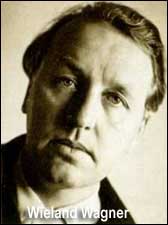 Lehnoff’s mentor was none other than Wieland Wagner, the composer’s grandson, who from 1951 until his death in 1966, directed a number of Wagner’s operas at the family’s theater in Bayreuth and elsewhere. Wieland’s goal was to strip his grandfather’s operas of everything Germanic and Nordic. This was a tall order, since all ten of Wagner’s mature operas are based on myths, romances, and folktales from Northern Europe. Not to mention the fact that they were written in German. These elements could not be changed without destroying the works themselves.
Lehnoff’s mentor was none other than Wieland Wagner, the composer’s grandson, who from 1951 until his death in 1966, directed a number of Wagner’s operas at the family’s theater in Bayreuth and elsewhere. Wieland’s goal was to strip his grandfather’s operas of everything Germanic and Nordic. This was a tall order, since all ten of Wagner’s mature operas are based on myths, romances, and folktales from Northern Europe. Not to mention the fact that they were written in German. These elements could not be changed without destroying the works themselves.
But Wieland felt he could get away with changing traditional stagings and costumes, for there has always been some creative leeway in staging operas, even though Wagner himself had very definite ideas about how his operas should be staged, and these ideas were developed after his death, primarily by his widow Cosima, into what has become the archetypal Wagner style of winged helmets and romantic, fairytale backdrops.
Wieland’s “New Bayreuth” was characterized by virtually empty stages. Sets were suggested and spaces demarcated by color and lighting effects. Costumes were “abstract,” “modernistic” or “futuristic” — anything but Germanic or Nordic. New Bayreuth was for music what the “international style” was for architecture: cold, clinical, inhumanly drab, and stripped of everything national, historical, or ethnic. In the words of Peter Jonas of the Bavarian State Opera, who approved of New Bayreuth, Wieland “took those myths and purged them of ideology and of the Nordic dream of identity and produced a theater of abstraction, of absolute integrity.” (Absolute betrayal is more like it.)
But why? During and after World War II, Richard Wagner and his family were targets of especially intense hatred from the Allies and, behind them, the Jews. Wagner was a German nationalist, a racist, a pagan, and an anti-Semite. Adolf Hitler was deeply influenced by Wagner’s music and ideas. Hitler claimed that when he was a teenager, he was first inspired to pursue a political career by Wagner’s early opera Rienzi.
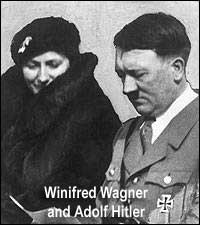 During his struggle for power, Hitler became friends with Houston Stewart Chamberlain and Winifred Wagner. Chamberlain was the husband of Wagner’s daughter Eva and the author of Foundations of the Nineteenth-Century, an interpretation of the history of the West in terms of the struggles between the Aryan and Jewish races. This book was deeply influenced by Wagner and in turn influenced Hitler’s racial interpretation of history and culture.
During his struggle for power, Hitler became friends with Houston Stewart Chamberlain and Winifred Wagner. Chamberlain was the husband of Wagner’s daughter Eva and the author of Foundations of the Nineteenth-Century, an interpretation of the history of the West in terms of the struggles between the Aryan and Jewish races. This book was deeply influenced by Wagner and in turn influenced Hitler’s racial interpretation of history and culture.
Winifred was the wife of Wagner’s son Siegfried, with whom she had four children, one of them being Wieland. When Siegfried died in 1930, Hitler became something of a surrogate father for Winifred’s children, who called him “Uncle Wolf.” Hitler and Winifred were such close friends that there were rumors of marriage plans. Hitler even secured an exemption from military service for Wieland during World War II.
Wieland Wagner was apparently one of those histrionic, self-hating, post-war Germans whose weak sense of self-worth had been totally crushed by relentless propaganda about German atrocities, real and fictitious, and German collective guilt for them. After the war, anti-German ethnic cleansing was Allied policy. This was accomplished not just by the expulsion of fourteen million Germans from their homes in the East, not just by killing leading German nationalists and purging millions of their followers from positions of power and influence, but also by the suppression of German identity and nationalist sentiments in all realms of culture. The New Bayreuth style was of a piece with this policy. Perhaps Wieland thought he could redeem and ingratiate himself in the eyes of Germany’s new masters by ethnically cleansing his grandfather’s works. Lehnhoff, who is German as well, not a Jew, is carrying on the same program.
But there is no appeasing Jewish hatred. Jews can hold a grudge longer than any nation in history. To this day, there is an unofficial but very real ban on performing Wagner’s works in Israel. Although Wagner’s music has been advocated by many Jewish conductors, including George Solti, James Levine, and Daniel Barenboim, they defend his operas on musical grounds and for what is “universal” in their stories. As one would expect, given Jewish domination of the media, the arts, and the recording industry, the public is not allowed to hear voices that praise Wagner for what is particular about his operas — what is Germanic, what is Nordic.
I don’t doubt that Wagner’s operas have universal appeal and significance. Anyone can hum a tune and follow a story. But for some there is more to Wagner than just that. As a friend once said, “Mozart and Puccini are art; Wagner is religion.” Wagner is a religious experience because something deep in his music connects with something deep in certain listeners, something that has to do with what is particular to Nordic people.
C.S. Lewis once described how, when reading the Norse myths, the words “Baldur the beautiful is dead, is dead,” suddenly awakened deep racial memories or archetypes of the ice-clad wastes in which the White race, or at least its Nordic subrace, probably evolved. Wagner has the same effect. He stirs something in the blood, and he will continue to do so as long as his music and our race survive, no matter how badly his operas are parodied on the stage.
In the long run, Wieland Wagner and Nikolaus Lehnhoff and their kind will be forgotten. In the meantime, it is easy enough to avoid such travesties. There are CDs, DVDs, and no shortage of traditional productions. One can even enjoy Lehnhoff’s Dutchman if one knows the story in advance and is forewarned about the worst bits. When I found the production too distracting, it was easy enough to sweep it all away. All I did was close my eyes. Then there was just Wagner’s music, in all its undimmed glory.
* * *
Source: Racial Nationalist Library


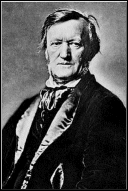


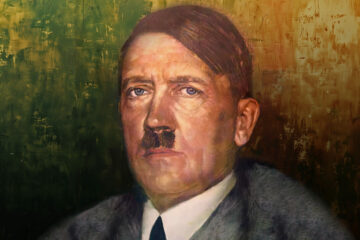
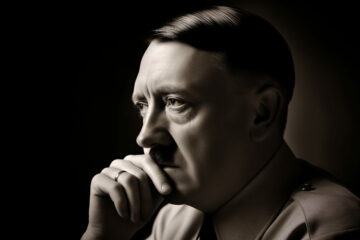
Traditional opera production, audio:
https://youtu.be/ibWxhwcZI_w . Most white ADD-mericans will be happy with the Overture: https://youtu.be/X6UUssaNt_o
I have never seen a Wagner opera, just listened to purely musical fragments and yet is so beautiful and grandiose that is almost impossible to describe. Wieland Wagner is a piece of s…t that typifies the vast majority of the Germans of today; snivelling cowards that spit over the graves of their glorious ancestors.
Regarding Lenhoff and other despicable traitors like him, that is what you can get nowadays. Wagner’s operas, like everything quinta-essentially Germanic, has to be destroyed. The war did not end in 1945 is still on and it will go on until the inevitable triumph of National Socialism.
Wagner, whose first wife was Jewish, became an “anti-Semite” after asking Meyerbeer for a letter of introduction so that he could apply for a job in the Jewish owned/controlled theatres.
He opened the letter to discover that Meyerbeer had written “Please take this imbecile off my hands.”
He decided to create his own theatre.
To “truthweed”: I wonder what would be the reason for you to say such vile lies about Richard Wagner. To begin with your idiotic, spiteful and, of course, false statement about Wagner’s first wife (Christine Wilhelmine Planer 1809-1866). She was of pure German stock (https://en.wikipedia.org/wiki/Minna_Planer)
He never asked Meyerbeer for anything. When they met in 1839 Wagner read the libretto of Rienzi to Meyerbeer who was impressed by it and recommended Wagner to the director of the Royal Saxon Opera in Dresden where Rienzi was performed for the first time.
https://en.wikipedia.org/wiki/Richard_Wagner#Early_career_and_marriage_(1833%E2%80%931842)
Nothing but spiteful lies.
Greetings Angelicus.
Perhaps I am mistaken. I attended a lecture by Sir Edward Downes in the 1970s. Theatre director Ralph Koltai also spoke for an hour regarding Wagner’s Jewish acquaintances and I believe that is where I heard the comment about Minna Planer.
The anecdote about Meyerbeer was mentioned on ABC Radio in Australia about ten years ago.
I will research my files for citations.
Greetings again Angelicus.
Immediately after my last posting I found the following at sermonsuite.com:
One who failed the test was the German pianist and operatic composer, Giacomo Meyerbeer. The musician sent a striving young self-proclaimed musical genius along to Leon Piller, who was at that time director of the Paris Opera, along with what the prodigy thought was a sealed letter of recommendation. When Piller opened the envelope, what he read was, “Take this imbecile off my hands.” The young man was Richard Wagner.
When I first heard the story the presenter stated that Wagner had opened the letter.
Again Angelicus, discog.com states:
A young aspiring musician was auditioned by composer Giacomo Meyerbeer in 1839. Meyerbeer graciously received the young man and gave him a letter of recommendation. The letter was sealed and addressed to Leon Pillet, director of the Paris Opera. It contained the recommendation to Pillet: “Please take this imbecile off my hands!”
The unwitting imbecile and bearer of the note was Richard Wagner.
Here are the notes on which I relied: Andrew Gray delivered a speech ‘Errors, Lies and Nonsense about Wagner’ at Adelaide Institute’s International Revisionist Symposium, 9 August 1998. (see Adelaide Institute Newsletter 230) Gray asked: Why was Berlin so important? The reason was that it was the only German theatre that paid royalties. The German system prior to 1870 was tilted against independent artists and composers because what the court theatres would do would give you a lump sum payment for all rights permanently. The lump sum payment that Wagner would get for say Tannhäuser from the Royal Court Theatre in Hannover was 2,000 florins, let’s say. It would be equivalent to $4,000 but nothing on which you could base an existence. Nothing on which you could buy or build… Read more »
White Americans with the classical music familiarity provided by the controlled media, love Wagner’s overtures. I prefer the choruses now, and they may reveal, intentionally or not, the spitefulness of Christianity on the medieval Germanic world. Tannhauser: https://youtu.be/mRgG65mt1VY
Greetings Travon.
Just for fun listen to the Helmsman’ s chorus from the Flying Dutchman then listen to “We sail the ocean blue” from Gilbert and Sulivan’s HMAS Pinafore.
Trutweed = I do thank you for your information and research. I am sorry about my inappropriate choice of words. I took to heart what I saw as an attack on Wagner’s character and overreacted. According to your information, which I found very useful, Andrew Gray made a good case for Wagner’s hostility towards Meyerbeer, which personally I think was undeserved, after all, it was thanks to Meyerbeer that Rienzi was performed at the Royal Saxon Opera in Dresden. (at least this is the information I gathered from Wikipedia, the source of it is great biography of Wagner by Ernest Newman) I found difficult to accept the story of Meyerbeer’s cruel letter of recommendation. If Meyerbeer considered Wagner an imbecile, why would he warmly recommend him to the director of… Read more »
I think 1927 Bayreuth Festival recording is the best record/CD I’ve owned or heard. When listening to Wagner I think it best to seek pre-WWII recordings. Not much point in seeing Wagner in live performance these days. I don’t think many have the attention span for it. That, and the Jews, in the music business factor. Which Wagner described quite well. The Romantic period was the culmination of musical evolution. Instruments were finally being constructed which better facilitated the works of the great composers, and allowed for greater dynamics than were previously possible. The newly found capabilities of instruments created by Torres, Stradivarius, and others, made possible music of greater variance in volume, and tonal color. Making the great music of Tarrega, Chopin, and Paganini viable.